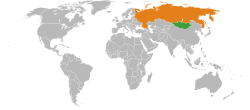Mongolia–Russia border
The Mongolia–Russia border (Mongolian: Монгол-Оросын хил, Mongol-Orosın xil; Russian: Российско-монгольская граница, Rossijsko-mongoljskaja granica) is the international border between the Russian Federation (CIS member) and Mongolia. It is virtually all land. The total length of the border is 3485 km. The boundary is the third longest border between Russia and another country, behind the Kazakhstan-Russia border and the China-Russia border.

History
.jpg)
The Russian state expanded into the regions north of today's Mongolia in the 17th century. Much of the line of the today's Mongolia–Russia border line was set by the Treaty of Kyakhta (1727) between the Russian and Qing Empires (the Mongolia at the time being part of the Qing state); however, the treaty left Tuva on the Chinese (Qing) side of the border.
Mongolia's northern border assumed its nearly modern shape in 1911, as Tuva was separated from Mongolia in the breakup of the Qing Empire (see Mongolian Revolution of 1911), and soon became a Russian protectorate. Although an independent Tuvan People's Republic was declared in 1921, this small country became fully annexed into the Soviet Union in 1944, whereupon the former Mongolia–Tuva border became a section of the Mongolia–Soviet border. The latter stayed stable for the rest of the Soviet Union's existence, and continued as the Mongolia–Russia border after the dissolution of the Soviet Union in 1991.
Tripoints
The eastern and western end points of the Mongolia–Russia border are "tripoints", i.e. junctions with the China–Russia border and the China–Mongolia border. A special trilateral agreement, signed on January 27, 1994 in Ulaanbaatar, determines the location of these two "tripoints". The agreement is based on earlier bilateral treaties between the parties involved.[1]
The trilateral agreement specifies that a border monument was to be erected at the eastern tripoint, called Tarbagan-Dakh (Ta'erbagan Dahu, Tarvagan Dakh);[1] a later trilateral protocol determined the tripoint's geographic coordinates as 49°50′42.3″N 116°42′46.8″E.[2] The border monument and the access roads for it are visible on Google Maps, at approximately 49.845625°N 116.714026°E).[1]
The trilateral agreement states that no marker will be erected at the western tripoint,[1] which was defined as the peak of the mountain Tavan-Bogdo-Ula (Kuitunshan 奎屯山, Tavan Bogd Uul; elevation approx. 4081–4104 m, location, 49°10′13.5″N 87°48′56.3″E[3]), due to its remote and hard to access location, on a mountain covered with eternal snows.[3]
Border crossings
At the border there are ten official crossing points.[4]
Two of them are railway crossings, but only one (Naushki) has passenger traffic.
Three highway border crossing points are designated as "multilateral", for any passport holders (Tashanta-TcagaanNur, Kyakhta-Aganbulag, Solovjowsk - Erentsav).
Another five highway border crossing points are designated as "bilateral", meaning that they are only open to the citizens of the two bordering countries, and not to third-country nationals. The border crossing point near famous Khövsgöl lake (Mondy-Khankh) is bilateral.
Border violations
According to an article published in 2005, the main problems at the Russian-Mongolian border, specifically in its Republic of Tuva section, were cross-border livestock theft (in both directions) and smuggling of meat.[5]
Administrative divisions

Federal subjects of Russia bordered by Mongolia
Mongolia borders four federal subjects of Russia:
- Altai Republic
- Tuva Republic
- Republic of Buryatia
- Zabaykalsky Krai
Provinces of Mongolia bordered by Russia
There are 8 provinces of Mongolia which border Russia:[6]
References
- Соглашение между Правительством Российской Федерации, Правительством Китайской Народной Республики и Правительством Монголии об определении точек стыков государственных границ трех государств (Заключено в г. Улан-Баторе 27 января 1994 года) Archived 2016-03-05 at the Wayback Machine (The Agreement between the Government of the Russian Federation, the Government of the People's Republic of China, and the Government of Mongolia on the determination of the points of junction of the national borders of the three states) (in Russian)
- ПРОТОКОЛ-ОПИСАНИЕ ТОЧКИ ВОСТОЧНОГО СТЫКА ГОСУДАРСТВЕННЫХ ГРАНИЦ ТРЕХ ГОСУДАРСТВ МЕЖДУ ПРАВИТЕЛЬСТВОМ Российской Федерации, ПРАВИТЕЛЬСТВОМ МОНГОЛИИ и ПРАВИТЕЛЬСТВОМ КИТАЙСКОЙ НАРОДНОЙ РЕСПУБЛИКИ Archived 2018-02-15 at the Wayback Machine (Protocol between the Government of the Russian Federation, the Government of Mongolia, and the Government of the People's Republic of China, describing the eastern junction point of the borders of the three states) (in Russian)
- ПРОТОКОЛ-ОПИСАНИЕ ТОЧКИ ЗАПАДНОГО СТЫКА ГОСУДАРСТВЕННЫХ ГРАНИЦ ТРЕХ ГОСУДАРСТВ МЕЖДУ ПРАВИТЕЛЬСТВОМ Российской Федерации, ПРАВИТЕЛЬСТВОМ МОНГОЛИИ и ПРАВИТЕЛЬСТВОМ КИТАЙСКОЙ НАРОДНОЙ РЕСПУБЛИКИ (ПОДПИСАН в г. ПЕКИНЕ 24.06.1996) Archived 2018-02-16 at the Wayback Machine (Protocol between the Government of the Russian Federation, the Government of Mongolia, and the Government of the People's Republic of China, describing the western junction point of the borders of the three states. Signed in Beijing, June 24, 1996) (in Russian)
- Mongolia/Russia Border Crossing No. 487: This extremely remote border crossing was closed to prevent smuggling and looting
- Datsyshen, Vladimir (Владимир Дацышен) (2005), "Потенциал конфликтности в зоне российско-монгольской границы в Туве — Журнал "Международные процессы"] (Conflict potential in the Russia-Mongolia border area in Tuva", Международные процессы (International trends), 3 (1(7)), archived from the original on 2016-03-04, retrieved 2015-07-02
- http://www.mongolia-attractions.com/map_mongolia.html